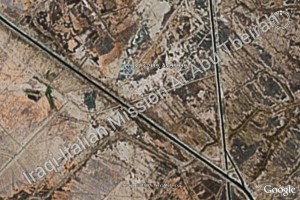Ancient name:
Bad-Tibira
Geographic coordinate:
31° 46′ 0″ N – 46° 0′ 0″ E
Governatorate – District – Sub-district:
Dhi-Qar – al Rifa’i – al Nasir
Nearest City:
About 10 kilometers north-east of Larsa, on the ancient Iturungal Canal, one of the two main courses of the Euphrates in antiquity. 3 km south-east from Sayyid Muhammad. 13 km north-west from al-Rifa’i. 12 km south-west from Qalat Sukar.
Chronological frame:
Late Uruk III or Early Dynastic (3000-2000 BC)
Excavations:
Only Surveyed. Looted.
Description:
Bad-Tibira, an ancient Sumerian city, is first mentioned in the Sumerian king list (an ancient text in the Sumerian language listing kings of Sumer from Sumerian and foreign dynasties) as “exercising kingship” over one of the five cities that were the centers of dynasties that ruled before the Deluge (“Great Flood”); the other four cities being Eridu, Larak, Shuruppak and Sippar. Bad-Tibira is listed as the “second city” following Eridu. The founder of Bad-Tibira was the king-god Enmenluanna.
If the Sumerian king list is to be believed, the rulers of Bad-Tibira — Enmenluanna, Enmengalanna and Dumuzid —and the other ancient dynasties enjoyed reigns of truly fantastic lengths; for this reason, the tradition may be partly mythic. Nevertheless, the existance and antiquity of four of the five cities has been established archaeologically.
In Sumerian hymns and mythology, Bad-Tibira is associated with Dumuzi (Akkadian Tammuz), the god of shepherds and their flocks, and one of the three rulers of the antediluvian dynasty. As the lover of Ishtar, he is also part of a tradition of dying (and reborn) gods. In Akkadian times, Tammuz was the name for the lunar month that approximately corresponds with July, and this is still the name for that month in the Jewish calendar.

Nome moderno:
Mada’in
Nome antico:
Bad Tibira
Coordinate geografiche:
31° 46′ 0″ N – 46° 0′ 0″ E
Governatorato-Distretti-Sub-distretto:
Dhi-Qar – al Rifa’i – al Nasir
Città più vicine:
A circa 10 chilometri a nord-est di Larsa, sull’antico Canale Iturungal, uno dei due corsi principali dell’Eufrate nell’antichità. 3 km a sud-est di Sayyid Muhammad. 13 km a nord-ovest di al-Rifa’i. 12 km a sud-ovest di Qalat Sukar.
Quadro storico:
Fine periodo Uruk III o protodinastico (3000-2000 a.C)
Scavi:
Solo rilevata. Saccheggiata.
Descrizione:
Bad-Tibira, un’antica città sumera, è la prima nella lista reale sumerica (un antico testo in lingua sumerica che presenta re sumeri provenienti da dinastie sumere o straniere) come “colei che esercita la regalità” su una delle cinque città che sono state i centri di dinastie che hanno governato prima del Diluvio (“Diluvio Universale”); le altre quattro città sono Eridu, Larak, Shuruppak e Sippar. Bad-Tibira è elencata come la “seconda città” dopo Eridu. Il fondatore di Bad-Tibira era il re-dio Enmenluanna. Se dobbiamo credere alla lista reale sumerica , i governanti di Bad-Tibira – Enmenluanna, Enmengalanna e Dumuzid -e le altre antiche dinastie godettero di regni con lunghezze veramente fantastiche; per questo motivo, la tradizione può essere parzialmente mitica. Tuttavia, l’esistenza e l’antichità di quattro delle cinque città è stata stabilita archeologicamente. Negli inni sumerici e nella mitologia, Bad-Tibira è associata con Dumuzi (accadico Tammuz), il dio dei pastori e de loro greggi, e uno dei tre sovrani della dinastia antidiluviana. In quanto amante di Ishtar, è anche parte di una tradizione del dio morente (che rinasce). In tempi accadici, Tammuz era il nome del mese lunare che corrisponde approssimativamente a luglio, e questo è ancora il nome per quel mese nel calendario ebraico.
